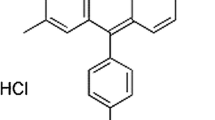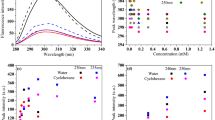Abstract
The photo-thermal lens technique is based on the measurement of the gradient temperature that is produced in an illuminated sample by laser beam as a result of non-radiative relaxation. The sensitivity of photo-thermal lens is higher than conventional absorption techniques, due to the direct measurement of absorbed energy. However, the main drawback of the photo-thermal lens technique is the inability to measure molecules that release their excess energy of absorption in the form of radiation relaxation. In fluorescence molecules, because their excess energy is released by radiation, the photo-thermal lens is insignificant. In this research, we aim to increase the photo-thermal lens sensitivity of the fluorescence molecules by selecting the appropriate acceptor for the fluorescence molecules as the donor. We investigated the effect of the presence of AuNPs on the photo-thermal lens of di-triazene (DTA) as fluorescence molecules. We observed that AuNPs enhanced the photo-thermal lens of DTA. The quantum yield of DTA was calculated to be 90.45%. The energy transfer from DTA to AuNPs occurs by fluorescence resonance energy transfer (FRET) mechanism. The FRET efficiency was 83.43%. In the presence of AuNPs, the photo-thermal lens of the DTA was amplified by four times more. The calibration curve of DTA is linear in the range of 0.1 to 110 ng/mL. The limited of detection (LOD) value of 0.08 ng/mL is calculated.









Similar content being viewed by others
Data Availability
The data that support the findings of this study are available from the corresponding author, upon reasonable request.
References
Gordon JP, Leite RCC, Moore RS et al (1965) Long-transient effects in lasers with inserted liquid samples. J Appl Phys 36:3–8. https://doi.org/10.1063/1.1713919
Sell JA (1988) Photothermal Investigations of Solids and Fluids. Acad Press. https://doi.org/10.1016/B978-0-12-636345-6.X5001-4
Coufal H, McClelland JF (1988) Photothermal and photoacoustic spectroscopy. J Mol Struct 173:129–140. https://doi.org/10.1016/0022-2860(88)80048-6
Bicanic D (1992) Photoacoustic and Photothermal Phenomena III. Springer-Verlag. https://doi.org/10.1007/978-3-540-47269-8
Franko M, Tran CD (1996) Analytical thermal lens instrumentation. Rev Sci Instrum 67:1–18. https://doi.org/10.1063/1.1147512
(2004) Peer Reviewed: Thermal Lens Microscopy and Microchip Chemistry. Anal Chem 76:52 A-60 A. https://doi.org/10.1021/ac041508d
Franko M (2008) Thermal lens spectrometric detection in flow injection analysis and separation techniques. Appl Spectrosc Rev 43:358–388. https://doi.org/10.1080/05704920802108032
Georges J (1999) Advantages and limitations of thermal lens spectrometry over conventional spectrophotometry for absorbance measurements. Talanta 48:501–509. https://doi.org/10.1016/s0039-9140(98)00242-2
Proskurnin MA, Volkov DS, Gor’kova TA et al (2015) Advances in thermal lens spectrometry. J Anal Chem 70:249–276. https://doi.org/10.1134/S1061934815030168
Demuyser L, Van Genechten W, Mizuno H et al (2018) Introducing fluorescence resonance energy transfer-based biosensors for the analysis of cAMP-PKA signalling in the fungal pathogen Candida glabrata. Cell Microbiol 20:e12863. https://doi.org/10.1111/cmi.12863
Zong H, Wang J, Mu X et al (2018) Physical mechanism of photoinduced intermolecular charge transfer enhanced by fluorescence resonance energy transfer. Phys Chem Chem Phys 20:13558–13565. https://doi.org/10.1039/C8CP01496E
Widengren J, Schweinberger E, Berger S, Seidel CAM (2001) Two new concepts to measure fluorescence resonance energy transfer via fluorescence correlation spectroscopy: theory and experimental realizations. J Phys Chem A 105:6851–6866. https://doi.org/10.1021/jp010301a
Moroz P, Jin Z, Sugiyama Y et al (2018) Competition of charge and energy transfer processes in donor–acceptor fluorescence pairs: calibrating the spectroscopic ruler. ACS Nano 12:5657–5665. https://doi.org/10.1021/acsnano.8b01451
Lerner E, Cordes T, Ingargiola A et al (2018) Toward dynamic structural biology: two decades of single-molecule Förster resonance energy transfer. Science (80- ) 359:eaan1133. https://doi.org/10.1126/science.aan1133
Kastantin M, Faulón Marruecos D, Grover N et al (2017) Connecting protein conformation and dynamics with ligand–receptor binding using three-color Förster resonance energy transfer tracking. J Am Chem Soc 139:9937–9948. https://doi.org/10.1021/jacs.7b03978
Denisov SA, Gan Q, Wang X et al (2016) Electronic energy transfer modulation in a dynamic foldaxane: proof-of-principle of a lifetime-based conformation probe. Angew Chem Int Ed 55:1328–1333. https://doi.org/10.1002/anie.201508611
Stanisavljevic M, Krizkova S, Vaculovicova M et al (2015) Quantum dots-fluorescence resonance energy transfer-based nanosensors and their application. Biosens Bioelectron 74:562–574. https://doi.org/10.1016/j.bios.2015.06.076
Chou KF, Dennis AM (2015) Förster Resonance Energy Transfer between Quantum Dot Donors and Quantum Dot Acceptors. Sensors (Basel) 15:13288–13325. https://doi.org/10.3390/s150613288
Fan L, Hu Y, Wang X et al (2012) Fluorescence resonance energy transfer quenching at the surface of graphene quantum dots for ultrasensitive detection of TNT. Talanta 101:192–197. https://doi.org/10.1016/j.talanta.2012.08.048
Sreenath K, Yuan Z, Allen JR et al (2015) A fluorescent indicator for imaging lysosomal Zinc(II) with Förster Resonance Energy Transfer (FRET)-enhanced photostability and a narrow band of emission. Chem – A Eur J 21:867–874. https://doi.org/10.1002/chem.201403479
Chen H, Puhl HL 3rd, Koushik SV et al (2006) Measurement of FRET efficiency and ratio of donor to acceptor concentration in living cells. Biophys J 91:L39–L41. https://doi.org/10.1529/biophysj.106.088773
Zal T, Gascoigne NRJ (2004) Photobleaching-corrected FRET efficiency imaging of live cells. Biophys J 86:3923–3939. https://doi.org/10.1529/biophysj.103.022087
Wallrabe H, Periasamy A (2005) Imaging protein molecules using FRET and FLIM microscopy. Curr Opin Biotechnol 16:19–27. https://doi.org/10.1016/j.copbio.2004.12.002
Thaler C, Koushik SV, Blank PS, Vogel SS (2005) Quantitative multiphoton spectral imaging and its use for measuring resonance energy transfer. Biophys J 89:2736–2749. https://doi.org/10.1529/biophysj.105.061853
Moustaoui H, Saber J, Djeddi I et al (2019) Shape and size effect on photothermal heat elevation of gold nanoparticles: absorption coefficient experimental measurement of spherical and urchin-shaped gold nanoparticles. J Phys Chem C 123:17548–17554. https://doi.org/10.1021/acs.jpcc.9b03122
Issaad D, Moustaoui H, Medjahed A et al (2017) Scattering correlation spectroscopy and raman spectroscopy of thiophenol on gold nanoparticles: comparative study between nanospheres and nanourchins. J Phys Chem C 121:18254–18262. https://doi.org/10.1021/acs.jpcc.7b05355
Santhi A, Kala UL, Nedumpara RJ et al (2004) Thermal lens technique to evaluate the fluorescence quantum yield of a Schiff base. Appl Phys B 79:629–633. https://doi.org/10.1007/s00340-004-1606-3
Hanžić N, Jurkin T, Maksimović A, Gotić M (2015) The synthesis of gold nanoparticles by a citrate-radiolytical method. Radiat Phys Chem 106:77–82. https://doi.org/10.1016/j.radphyschem.2014.07.006
Patel AS, Sahoo H, Mohanty T (2016) Investigating the energy transfer from dye molecules to DNA stabilized Au nanoparticles. J Fluoresc 26:1849–1855. https://doi.org/10.1007/s10895-016-1878-0
Acknowledgments
The authors appreciation from Dr. Mohammad Kazem Rofouei professor of analytical chemistry for the support in preparing the di-triazene.
Author information
Authors and Affiliations
Contributions
All authors have read and agreed to the published version of the manuscript.
Corresponding author
Ethics declarations
Conflict of Interest
The author(s) declares that they have no competing.
Code Availability
Not applicable.
Additional information
Publisher’s Note
Springer Nature remains neutral with regard to jurisdictional claims in published maps and institutional affiliations.
Rights and permissions
About this article
Cite this article
Shokoufi, N., Vaziri Heshi, S. Enhancmentation of Photo-Thermal Lens of Fluorescence Molecules by Fluorescence Resonance Energy Transfer Mechanism. J Fluoresc 31, 587–593 (2021). https://doi.org/10.1007/s10895-020-02676-y
Received:
Accepted:
Published:
Issue Date:
DOI: https://doi.org/10.1007/s10895-020-02676-y




